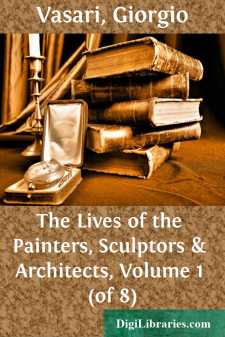Categories
- Antiques & Collectibles 13
- Architecture 36
- Art 48
- Bibles 22
- Biography & Autobiography 813
- Body, Mind & Spirit 142
- Business & Economics 28
- Children's Books 14
- Children's Fiction 11
- Computers 4
- Cooking 94
- Crafts & Hobbies 4
- Drama 346
- Education 46
- Family & Relationships 57
- Fiction 11828
- Games 19
- Gardening 17
- Health & Fitness 34
- History 1377
- House & Home 1
- Humor 147
- Juvenile Fiction 1873
- Juvenile Nonfiction 202
- Language Arts & Disciplines 88
- Law 16
- Literary Collections 686
- Literary Criticism 179
- Mathematics 13
- Medical 41
- Music 40
- Nature 179
- Non-Classifiable 1768
- Performing Arts 7
- Periodicals 1453
- Philosophy 64
- Photography 2
- Poetry 896
- Political Science 203
- Psychology 42
- Reference 154
- Religion 513
- Science 126
- Self-Help 84
- Social Science 81
- Sports & Recreation 34
- Study Aids 3
- Technology & Engineering 59
- Transportation 23
- Travel 463
- True Crime 29
The Lives of the Painters, Sculptors & Architects, Volume 1 (of 8)
by: Giorgio Vasari
Categories:
Description:
Excerpt
PREFACE TO THE LIVES
I am aware that it is commonly held as a fact by most writers that sculpture, as well as painting, was naturally discovered originally by the people of Egypt, and also that there are others who attribute to the Chaldeans the first rough carvings of statues and the first reliefs. In like manner there are those who credit the Greeks with the invention of the brush and of colouring. But it is my opinion that design, which is the creative principle in both arts, came into existence at the time of the origin of all things. When the Most High created the world and adorned the heavens with shining lights, His perfect intellect passing through the limpid air and alighting on the solid earth, formed man, thus disclosing the first form of sculpture and painting in the charming invention of things. Who will deny that from this man, as from a living example, the ideas of statues and sculpture, and the questions of pose and of outline, first took form; and from the first pictures, whatever they may have been, arose the first ideas of grace, unity, and the discordant concords made by the play of lights and shadows? Thus the first model from which the first image of man arose was a lump of earth, and not without reason, for the Divine Architect of time and of nature, being all perfection, wished to demonstrate, in the imperfection of His materials, what could be done to improve them, just as good sculptors and painters are in the habit of doing, when, by adding additional touches and removing blemishes, they bring their imperfect sketches to such a state of completion and of perfection as they desire. God also endowed man with a bright flesh colour, and the same shades may be drawn from the earth, which supplies materials to counterfeit everything which occurs in painting. It is indeed true that it is impossible to feel absolutely certain as to what steps men took for the imitation of the beautiful works of Nature in these arts before the flood, although it appears, most probable that even then they practised all manner of painting and sculpture; for Bel, son of the proud Nimrod, about 200 years after the flood, had a statue made, from which idolatry afterwards arose; and his celebrated daughter-in-law, Semiramis, queen of Babylon, in the building of that city, introduced among the ornaments there coloured representations from life of divers kinds of animals, as well as of herself and of her husband Ninus, with the bronze statues of her father, her mother-in-law, and her great-grandmother, as Diodorus relates, calling them Jove, Juno, and Ops—Greek names, which did not then exist. It was, perhaps, from these statues that the Chaldeans learned to make the images of their gods. It is recorded in Genesis how 150 years later, when Rachel was fleeing from Mesopotamia with her husband Jacob, she stole the idols of her father Laban. Nor were the Chaldeans singular in making statues, for the Egyptians also had theirs, devoting great pains to those arts, as is shown by the marvellous tomb of that king of remote antiquity, Osimandyas, described at length by Diodorus, and, as the severe command of Moses proves, when, on leaving Egypt, he gave orders that no images should be made to God, upon pain of death....


